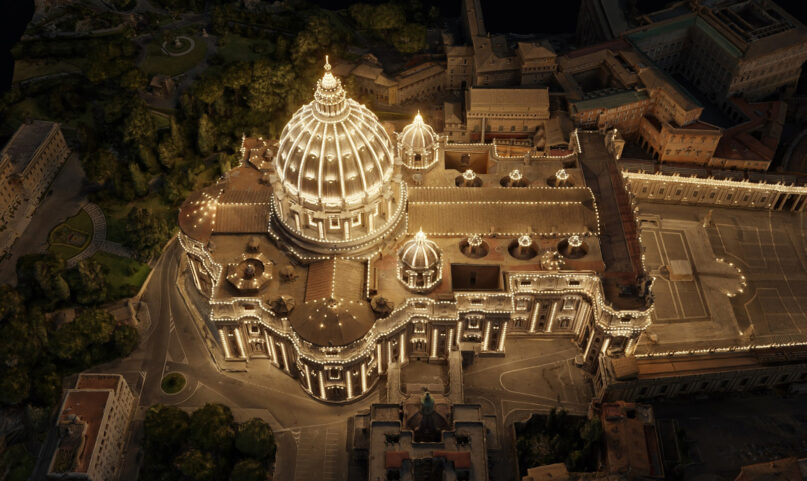VATICAN CITY (RNS) — Visitors to Rome will have the opportunity to experience St. Peter’s Basilica in a new way as part of an immersive exhibit, both in person and online, created through a partnership between the Vatican and Microsoft using AI technology.
The ambitious “digital twin” exhibit of the sacred Catholic site where St. Peter is believed to have been buried will also be available on Minecraft Education starting in January.
“When you think about this partnership, I think it’s as extraordinary as the project itself: The oldest organization in the world coming together with the newest technology we have ever seen,” said Brad Smith, vice chair and president of Microsoft, during a press conference unveiling the project on Monday (Nov. 11).
For three weeks, drones led by the French company Iconem hovered inside and above St. Peter’s Basilica, taking over 400,000 highly detailed pictures of every nook and cranny of the massive structure. AI technology coordinated the drones, which used lasers to detect the exact location of the objects they photographed. The data was collected by state-of-the-art AI processors that used a special algorithm to scan all the pictures and reconstruct the basilica.
Smith said he didn’t know the exact cost of the operation, which Microsoft offered the Vatican for free, but added that the “substantial project” required the effort of many of the company’s experts.

An AI-generated image of St. Peter’s Basilica and Vatican City at night. (Image courtesy Microsoft)
The AI-generated replica and pictures will form part of an immersive exhibit titled “Petros Eni,” or “Peter is here.” Smith said that the permanent exhibit will be “a story in three chapters.” The first details the life and death of the apostle Peter; the second delves into the history of the Italian High Renaissance basilica completed in 1615; the third showcases the discoveries and images made available through AI.
Smith said that through data and AI technologies, visitors will have the opportunity to “see this basilica as I think no generation has seen it before.”
In 2025, Rome and the Vatican will host a jubilee, a 25-year anniversary. More than 30 million pilgrims are expected to visit to pray for indulgences and peace. The 3D replica of St. Peter’s is one of the many works and installations that the Vatican is preparing for the event. The Fabric of St. Peter, founded in 1506 as an institution of the Holy See to preserve and safeguard the basilica, will also launch a new website and app for visitors.
“It’s an effort to decode the interlocking of history, art and spirituality that make the basilica one-of-a-kind in the world,” said Cardinal Mauro Gambetti, archpriest of St. Peter’s Basilica and president of the Fabric, during the press conference.
The cardinal also voiced his hope that these technologies will help streamline the flux of visitors at the Vatican and avoid long lines. St. Peter’s Basilica will also be accessible online in January via a website showcasing all of the pictures and data collected by the drones in interactive 3D models. There will also be an online exhibit, Petros Eni Octagon, with a guided tour of the life and legacy of St. Peter.

A view of St. Peter’s Basilica from a balcony. (Image courtesy Microsoft)
Schools will be able to introduce the basilica to a new generation of students through Minecraft Education, based on the best-selling video game Minecraft. “We are taking this story to the world,” Smith said, “and to a new generation of people.”
Thousands of pictures of the basilica will highlight information about the structure that had been lost to time and that can assist in restoration projects. The drones found missing mosaic tiles and spider nests, but they also created a lasting imprint of the architecture and art of St. Peter’s that can help in the reconstruction of the basilica if it is damaged.
“We now have a model that will last forever,” Smith said, noting that since the blaze of Notre Dame Cathedral in France, preserving the integrity of historical sights has become an even more urgent concern.

Microsoft has already contributed to creating detailed copies of Mont-Saint-Michel in France and ancient Olympia in Greece. Its collaboration with the Vatican goes back to 2020 when the tech giant signed the Rome Call for AI Ethics, a Vatican project to promote responsible development of AI technologies.
Gambetti said he first suggested the idea of bringing the art of St. Peter’s Basilica to Smith two years ago, while they both looked at Michelangelo’s Pietà sculpture.
“Our main concern is about preserving the basilica for another 1,000 years, and those who will safeguard it in the future should have the same mentality,” he said.

An AI-generated image from scans of the Gian Lorenzo Bernini baldachin in St. Peter’s Basilica at the Vatican. (Image courtesy Microsoft)
In a meeting on Monday with members of the Fabric and representatives from Microsoft, including Smith, Pope Francis stressed that the project should highlight the sacredness, mission and history of the basilica and be a service to others.
“Everyone, truly everyone, must feel welcomed in this great house: those who have faith and those in search of faith; those who come to contemplate the artistic beauty of Rome and those who want to decipher its cultural codes,” he said.
As an independent nonprofit, RNS believes everyone should have access to coverage of religion that is fair, thoughtful and inclusive. You can help keep our news and commentary free for all by becoming one of our supporters. And during our end-of-year fundraising campaign, your gift can go further: Starting Nov. 1, your donation will be DOUBLED, dollar for dollar, by a generous gift from our Board of Directors. Please consider chipping in today!
Deborah Caldwell, CEO and Publisher
Discover more from CaveNews Times
Subscribe to get the latest posts sent to your email.


























![Exploring the Serene Beauty of Nature: A Reflection on [YouTube video title]](https://cavemangardens.art/storage/2024/04/114803-exploring-the-serene-beauty-of-nature-a-reflection-on-youtube-video-title-360x180.jpg)


























